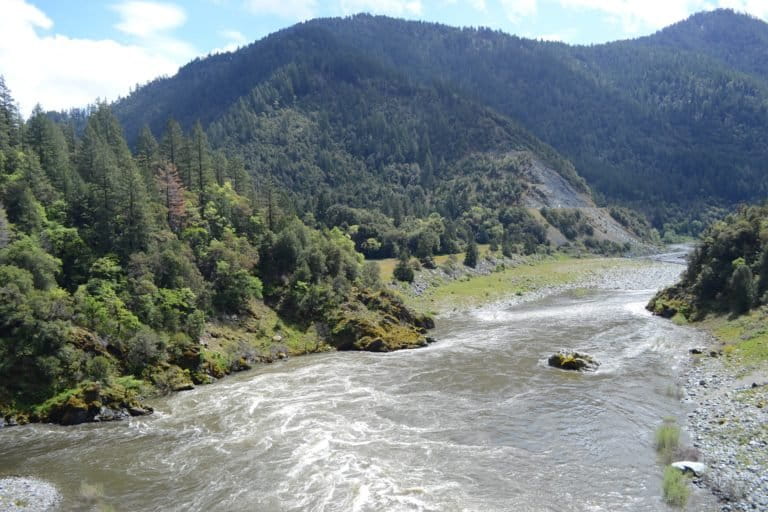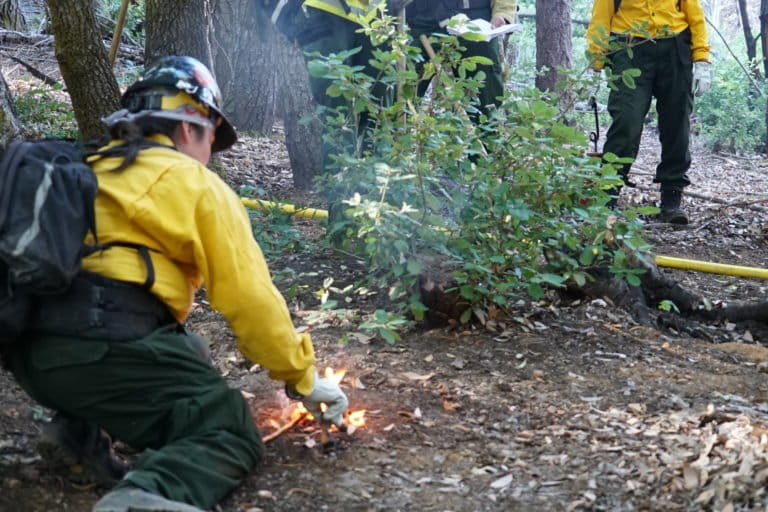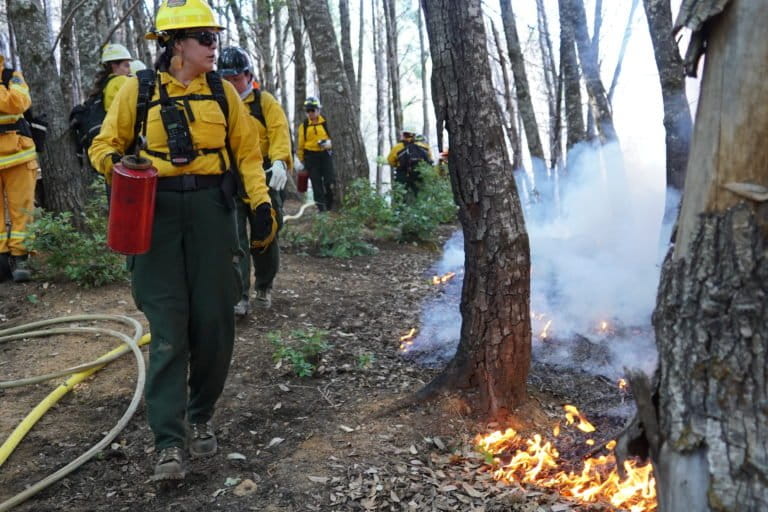- The Karuk Tribe partnered with the U.S. Forest Service and other stakeholders to reintroduce traditional burning to help restore forests in the Klamath Mountains.
- The four-year-old project aims to prevent wildfires and make overgrown forests in Northern California look more like they did thousands of years ago when the Tribe stewarded them.
- So far, the project’s successes have been encouraging, however, the Tribe and Forest Service have encountered hurdles in their relationship and have had difficulty agreeing on different fire techniques.
- The project hopes to make burning a seasonal and sustainable part of ecosystem management.
ORLEANS, California—An elemental smell wafts through the Klamath mountains in early autumn—woodsmoke. Despite the U.S. Forest Service’s intermittent bans on lighting fires in the forest, the Karuk Tribe is maintaining its cultural practice of intermittent burns to conserve their traditional lands in northern California.
With the Tribe’s oversight, a partnership with the Forest Service and other stakeholders introduced the Somes Bar Restoration Project in 2018. Using traditional fire techniques, it targets 2,254 hectares (5,570 acres) of land. Although the project is multilayered and partners hold different priorities, all agree that the project is an ongoing, if slow-moving, success to safeguard the rich biodiversity of hardwoods, conifers, deciduous oaks and an almost endless variety of alpine plant life in the Klamath mountains.
And their restoration tool: fire.

“Our purpose is to protect this place,” says Annelia Hillman, a Yurok Tribe member who participated in a fire managing training session organized by the Karuk Tribe. “We need to be able to take care of it.”
In the past few years, California wildfires have been burning hotter and with more intensity, which makes them harder to fight. They destroy habitats, like a grove of redwoods, that are generally resilient to low-intensity fires. The ongoing drought, and the proliferation of dry leaves, ferns, twigs and other organic matter on the forest floor that catch fire easily, are also factors in how destructive the fires become.
Although it may seem counterintuitive to use fire to restore habitats destroyed by wildfire outbreaks and blistering under the pressure of droughts, low-level and controlled burnings in the Klamath mountains is a historical forest-management practice. According to a recent study published in the Proceedings of the National Academy of Sciences, tribal burnings in the Californian forest “promoted [the] long-term stability of the forest structure and composition for at least one millennium.”
So far, the project’s results have been encouraging. After a fire burns through the flammable undergrowth, it creates space for the mature trees to grow fully and allows for increased seed germination of the larger species, which take more time to grow. In a healthy grove of mature trees, natural pathways form, allowing for more critter and human movement within them.

“Imagine a forest landscape with a high degree of visibility around you,” explains Clarke Knight, the study’s lead author and a USGS Geological Survey research geographer.
With a cleared floor and less fine fuels (fast-drying flammable organic matter such as leaves and ferns), it’s more difficult for wildfires to ignite and spread.
“The places that we actually have fire on the ground, you don’t see as much duff [organic matter on the forest floor],” says Bill Tripp, director of natural resources and environmental policy for the Karuk Tribe. Tripp is also a co-lead on the Western Klamath Restoration Partnership, which organized the Somes Bar Restoration Project.
Tripp mentions how project workers have seen several wildfires burn up to the fire line where the project’s prescribed burns caused a break, ultimately stopping the fire from moving further into treated forests.
Once the forest is more open, maintaining the land with cultural burning—using fire when necessary to keep the ecosystem healthy based on Indigenous knowledge of the land and resources—will be a natural, seasonal process.

“We look at the landscape and say, okay, day one, two and three, we are going to burn whitethorn [shrubs], day four and five, we are going to burn under the pines, and day six, seven and eight we are going to burn under the black oaks,” Tripp tells Mongabay.
Tripp explains that prescribed burns don’t need to be large to be effective. If a grove of black oaks needs some fire in its undergrowth because it’s choking out mature trees, it’s possible, when prepared correctly, for only a couple of people to burn 4 to 8 hectares (10 to 20 acres).
The important part, partners say, is to keep going.
Read more: Fire and agroforestry revive California indigenous groups’ traditions
The bureaucracy of fire
“When it comes to the Karuk Tribe, we have a constitution, and our sovereignty is embedded in that constitution,” says Bill Tripp.
“But when the federal government and agencies work with Tribes, they look at us more like an NGO with a couple of special privileges.”
The land where the Somes Bar Project is located is not for the amateur hiker. Full of black and white oak, tan oak, madrones, Douglas fir, and red fir on steep slopes and outcrops, it’s a land carved from 1,000 years of human history. This was a period when the Karuk used low-intensity fire on the forest floor with regularity, without damaging the canopy, to create trails and promote root and berry growth. It was important to allow space in between the trees, to better collect acorns and cultivate mushrooms.

The inevitability of “bringing fire in” wasn’t always a possibility. The forest reserve started mandated fire suppression across the country after it was established in 1905. In the Klamath Mountains, suppression became effective in the 1920s – bringing the fire burn practices to a halt. And by 1945, fire suppression allowed fuels to grow over paths and choke out mature trees.
For many in the Tribe, in order to continue traditional fire techniques at a reasonable frequency, such as patch burning a specific coordinated unit, which there are hundreds of within a particular project area, there is still a lot of red tape.
Even though the project was supposed to make it more streamlined, burning certain kinds of flash fuels (highly combustible fuels such as dry leaves and pine) is still a no-go.
“The agreement structures for things like the tree thinning components just really aren’t designed for Tribes,” says Tripp. “They have requirements in them that are not things that Tribes legally have to abide by. And it would be nice to see an agreement structure developed that actually considers the differences, and the sovereignty that Tribes have.”
The land is mostly administered by the Service but is known as traditional Tribe land. The Tribe doesn’t think it should be beholden to national burn bans that stop all prescribed burns in federally administered national forests.

In July, a national burn ban paused all prescribed burning, not just in the Six Rivers National Forest, where the project area is located, but throughout the U.S. In late October, the project partners received approval to start prescribed burns again.
“That relationship between us hasn’t always been good, and there are a lot of reasons why,” says Nolan Colegrove, a district ranger and line officer in the Six Rivers National Forest, about the Service’s relationship with the Tribes in the region.
“We got to the point of necessitating a meeting between the collaborative partners to better understand the values and each other’s needs and the path forward.
“The wildfires are getting bad in the area, worse every year, and there are more megafires—the necessity was to sit down and say, ‘hey, we need to do something together.’”
“Everyone’s agreed on what work needs to be done, but it’s years of planning to get there […] just years of planning, to go cut sticks in the woods,” says Eric Darragh, co-director of fire and forestry for the Mid-Klamath Watershed Council.
Darragh came to the project in 2019 and implemented the first unit in the Somes project. He says what happens before a burn is reducing the “small diameter fuels,” piling the fuels and burning those piles “when the season is right” in order to prepare a unit for a prescribed fire.


Timing the right window for a burn is also part of a tricky and logistical process. It’s best to burn piles in the fall and winter—due to cultural concerns for songbirds in the spring and avoiding prolonged heat and wildfire risk in summer. But the winds or high moisture levels of fall and winter can determine whether or not a burn can actually take place.
Darragh said in the summer of 2021, there were over 800 piles in between three of the four project areas at risk of catching fire by a nearby wildland fire, which would have led to a nightmarish high-intensity burn.
“It’s a reality of doing this work,” he says.
The piles didn’t alight because some rain and a strong fire line prevented the wildland fire from moving into the area.
“Right now, our forest is in such a state that either fire burn way too hot because of how much fuels there are, or they don’t dry out enough in our burn seasons because they are overloaded with fuels,” he says. “We’re prepping the perimeter, getting ready to bring fire in.”
The path forward
For the agencies, Tribes and communities in the Klamath Mountains, the Somes Bar project is only the beginning of a long-term process of managing the land for a seasonal cycle of prescribed burns, and eventually, the Tribes are hoping for more cultural burning to maintain it.
Federal grant money for the project has helped keep the momentum going because reducing the intensity of wildfires is a top priority in fighting the climate crisis.
The next collaborative project focal area, through the WKRP, called Ikxariyatuuyship in the Karuk language or Spirit People Mountain, includes a ceremonial burn area. It’s currently in the planning phase.

“We are helping move in the direction to power in collective voices,” said Analisa Tripp of the Karuk’s leadership in the project.
Colegrove said the relationship between the Tribes and the Service is vastly better than what it was in the recent past.
“It’s a huge step from where we were two years ago because we couldn’t let them be out there by themselves, we had to have our own federal burn boss on site,” he said of burning on federally administrated land. “But now, for that level of burn, they are on their own. And we can look at going further, and we probably will, but we want to do this good for a while.”
“No individual makes a decision here,” said Darragh. “You have to get buy-in and move forward as a group, which ultimately, I think is good, but it takes more time.”
And some issues surrounding the Somes Bar project area are still evolving. The U.S. Fish and Wildlife Service is seeking to designate critical habitat in the region for the Pacific marten, as well as protect the northern spotted owl against habitat loss. These issues, while addressing important parts of the Klamath Mountain ecosystem, are another hurdle to obtaining permits to burn in or near those areas.
For Bill Tripp, it’s one step forward, then another.
“[We are] work[ing] toward building that professional system to maintain the landscape for cultural burning again,” he said. “And at the same time, building that community foundation in a cultural context instead of in a highly regulated framework.
“A small group of people can come together, have some food, have some laughs, and get some work done.”
Banner image: Eric Darragh, the co-director of Fire and Forestry for the Mid-Klamath Watershed Council, is pointing out burn sites within the project area. Images by Carly Nairn.
Related listening from Mongabay’s podcast: We look at the major forest and conservation trends coming out of 2021 and 2022 with Mongabay founder and CEO Rhett Butler, and IUCN senior program officer, Swati Hingorani. Listen here:
Citations:
Clarke A. Knight, Lysanna Anderson, M. Jane Bunting and John J. Battles. (2022). Land management explains major trends in forest structure and composition over the last millennium in California’s Klamath Mountains. PNAS. doi.org/10.1073/pnas.2116264119
FEEDBACK: Use this form to send a message to the author of this post. If you want to post a public comment, you can do that at the bottom of the page.
